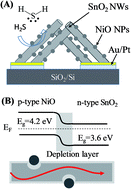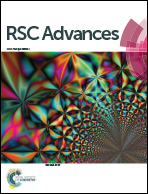An effective H2S sensor based on SnO2 nanowires decorated with NiO nanoparticles by electron beam evaporation†
Abstract
The highly toxic hydrogen sulphide (H2S) present in air can cause negative effects on human health. Thus, monitoring of this gas is vital in gas leak alarms and security. Efforts have been devoted to the fabrication and enhancement of the H2S-sensing performance of gas sensors. Herein, we used electron beam evaporation to decorate nickel oxide (NiO) nanoparticles on the surface of tin oxide (SnO2) nanowires to enhance their H2S gas-sensing performance. The synthesised NiO–SnO2 materials were characterised by field-emission scanning electron microscopy, transmission electron microscopy and energy dispersive spectroscopy analysis. H2S gas-sensing characteristics were measured at various concentrations (1–10 ppm) at 200–350 °C. The results show that with effective decoration of NiO nanoparticles, the H2S gas-sensing characteristics of SnO2 nanowires are significantly enhanced by one or two orders compared with those of the bare material. The sensors showed an effective response to low-level concentrations of H2S in the range of 1–10 ppm, suitable for application in monitoring of H2S in biogas and in industrial controls. We also clarified the sensing mechanism of the sensor based on band structure and sulphurisation process.



 Please wait while we load your content...
Please wait while we load your content...